In this article, we’ll take a closer look at Stratified vs Cluster Sampling with examples. There are two main types of sampling methods used in research: stratified and cluster. But what’s the difference between the two? And which one is better?
Probability sampling is a component of statistical analysis and includes both stratified sampling and cluster sampling. Choosing samples from a large population is a process known as probability sampling, which is used for any type of research study.
The idea behind probability sampling is to choose a sample at random in order to conduct survey research.
Stratified Sampling
A population is divided into strata in a probability sampling technique known as stratified sampling, and participants are then randomly chosen from each stratum. The strata of a stratified sampling scheme must be homogeneous, collectively exhaustive, and also mutually exclusive. A subset of the population must be defined by the stratum.
Additionally, each component of the sample must belong to one and only one stratum in the population in order for it to be considered distinct. This suggests that the samples must include the entire population. Each stratum uses basic random sampling to assure accuracy and minimize sampling error.
The types of stratified sampling are:
- Proportionate Stratified Sampling
- Disproportionate Stratified Sampling
Example of Stratified Sampling
You want to know how a PHD degree might affect the income gap in your organization between different gender identities. You estimate that just a small percentage of the company’s employees have PhDs based on the employee list. In order to compare the differences between people who have a PHD degree and those who do not, you employ stratified sampling.
Cluster Sampling
When there is outward homogeneity but internal heterogeneity within clusters or groupings, the technique of cluster sampling is employed. It involves breaking up a population into various groups and clusters.
In order to achieve the required accuracy, cluster sampling is typically utilized to cut the number of interviews and the associated costs. The likelihood of random error is lowered when the bulk of the group’s heterogeneity is internal to the group and the sample size is fixed. The components in each of these clusters are then sampled. The entire population is divided into clusters, with each cluster’s components being randomly selected.
Cluster sampling techniques include
- Single-stage
- Two-stage
- Multiple-stage sampling
These techniques vary depending on how many steps are necessary to produce the desired sample.
Geography, buildings, schools, and other variables are frequently employed in the clustering population. An essential component of the optimum cluster sample design is the cluster’s heterogeneity.
Example of Cluster Sampling
Consider a café owner who is interested in the performance of all of its locations. Based on their locations, the owner groups the branches into clusters, and then randomly chooses samples from the clusters to examine performance.
Benefits of Cluster Sampling
■ Compared to other sample methods, cluster sampling is more economical.
■ Cluster sampling is used to handle surveys of huge populations.
■ The population should be varied for cluster sampling, but the clusters or groups must be homogeneous.
■ The clusters must accurately reflect the entire population.
Stratified vs Cluster Sampling
| Stratified Sampling | Cluster Sampling | |
| Definition | Population is split into homogeneous segments and a sample is then randomly selected from each section. | Individuals from the population are randomly chosen from so-called “clusters” of naturally occurring groups. |
| Selection of Sample | The population is drawn at random from each stratum. | Each individual is chosen at random from a cluster. |
| Selection of Population | Individually | Collectively |
| Segmentation | Asked for by the researcher | Naturally formed |
| Purpose | Improve representation and accuracy | Increase efficiency while lowering costs |
| Homogeneity | internal, involving the stratum | between different clusters outside |
| Heterogeneity | between different strata on the outside | with the clusters on the inside |
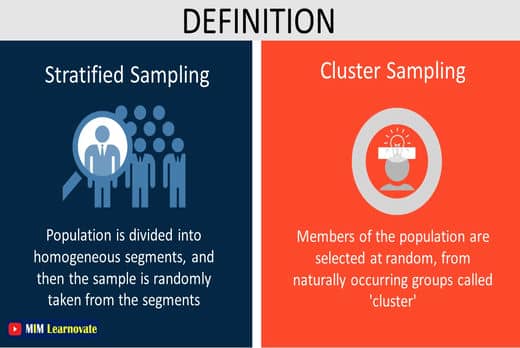
▶ Population is split into homogeneous segments and a sample is then randomly selected from each section in stratified sampling. ▶Whereas, in cluster sampling Individuals from the population are randomly chosen from so-called “clusters” of naturally occurring groups.
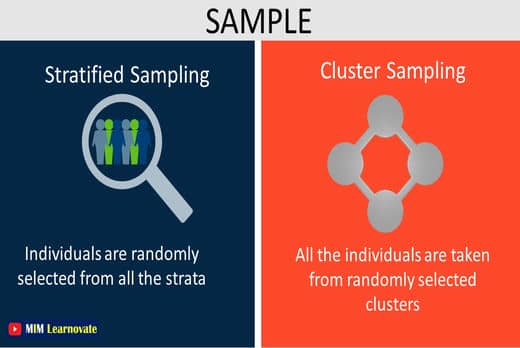
▶The population is drawn at random from each stratum in stratified sampling
▶ Each individual is chosen at random from a cluster in cluster sampling.
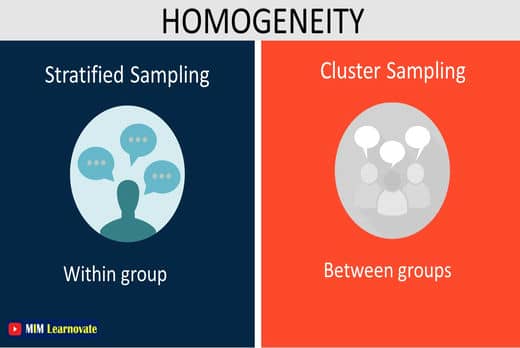
▶ Stratified Sampling‘s homogeneity is internal, involving the stratum. ▶ Whereas, cluster sampling‘s homogeneity is between different clusters outside
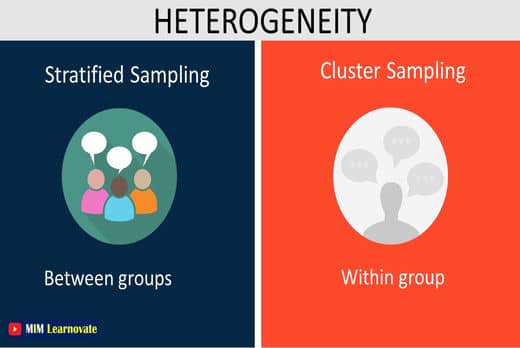
▶ Stratified Sampling‘s heterogeneity is between different strata on the outside. ▶ Whereas, cluster sampling‘s heterogeneity is with the clusters on the inside
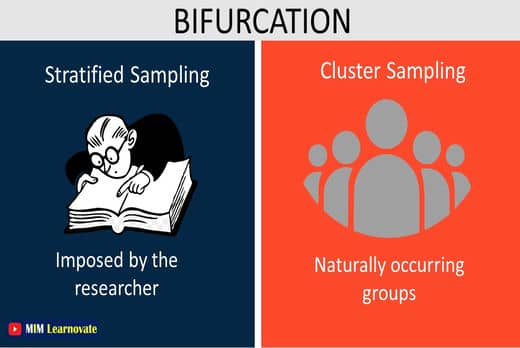
▶ In Stratified Sampling, segmentation is done by the researchers. ▶ The segmentation of cluster sampling is naturally formed.
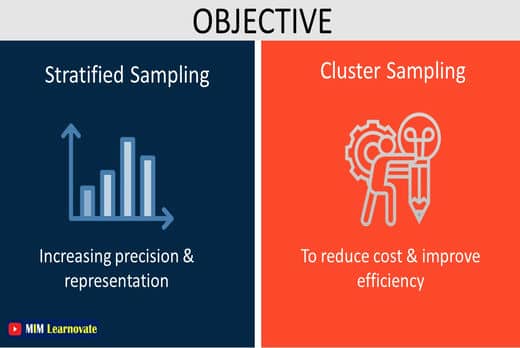
▶ Stratified Sampling improves representation and accuracy. ▶ Cluster sampling increases efficiency while lowering costs
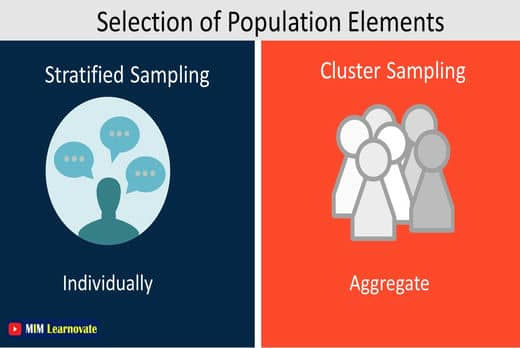
▶ Stratified Sampling‘s selection of population is on Individual basis. ▶ Whereas, cluster sampling’s selection of population is done collectively.
Other articles
Please read through some of our other articles with examples and explanations if you’d like to learn more about research methodology.
Comparision
- Basic and Applied Research
- Cross-Sectional vs Longitudinal Studies
- Survey vs Questionnaire
- Open Ended vs Closed Ended Questions
- Experimental and Non-Experimental Research
- Inductive vs Deductive Approach
- Null and Alternative Hypothesis
- Reliability vs Validity
- Population vs Sample
- Conceptual Framework and Theoretical Framework
- Bibliography and Reference
- Stratified vs Cluster Sampling
- Sampling Error vs Sampling Bias
- Internal Validity vs External Validity
- Full-Scale, Laboratory-Scale and Pilot-Scale Studies
- Plagiarism and Paraphrasing
- Research Methodology Vs. Research Method
- Mediator and Moderator
Comparision
- Independent vs. Dependent Variable – MIM Learnovate
- Research Article and Research Paper
- Proposition and Hypothesis
- Principal Component Analysis and Partial Least Squares
- Academic Research vs Industry Research
- Clinical Research vs Lab Research
- Research Lab and Hospital Lab
- Thesis Statement and Research Question
- Quantitative Researchers vs. Quantitative Traders
- Premise, Hypothesis and Supposition
- Survey Vs Experiment
- Hypothesis and Theory
- Independent vs. Dependent Variable
- APA vs. MLA
- Ghost Authorship vs. Gift Authorship
Research
- Research Methods
- Quantitative Research
- Qualitative Research
- Case Study Research
- Survey Research
- Conclusive Research
- Descriptive Research
- Cross-Sectional Research
- Theoretical Framework
- Conceptual Framework
- Triangulation
- Grounded Theory
- Quasi-Experimental Design
- Mixed Method
- Correlational Research
- Randomized Controlled Trial
- Stratified Sampling
- Ethnography
- Ghost Authorship
- Secondary Data Collection
- Primary Data Collection
- Ex-Post-Facto
Research
- Table of Contents
- Dissertation Topic
- Synopsis
- Thesis Statement
- Research Proposal
- Research Questions
- Research Problem
- Research Gap
- Types of Research Gaps
- Variables
- Operationalization of Variables
- Literature Review
- Research Hypothesis
- Questionnaire
- Abstract
- Validity
- Reliability
- Measurement of Scale
- Sampling Techniques
- Acknowledgements
Statistics



